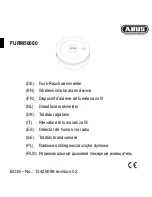
EXHAUST TUBE
SENSOR HEAD
SENSOR MODULE COVER
WIRING COMPARTMENT COVER
WIRING COMPARTMENT
SENSOR MODULE
SAMPLING
TUBE
NOTE: SENSOR HEAD IS ONLY
INCLUDED ON SPECIFIED MODELS.
SOLD
SEPERATELY
[4.2] ] DETERMINE MOUNTING LOCATION AND CONFIGURATION
On ducts wider than 18 inches it is recommended that the detector be
mounted downstream of a bend, obstruction in the duct, or the supply or
return air inlet .
Exception: Installation of duct detectors can be on or within a commercial
packaged rooftop heating and air-conditioning system, fire/smoke dampers
and economizers . They may be mounted in either the supply and/or return air
section as determined by local code .
Once a suitable location is selected, determine if the detector is to be mounted
in a side-by-side “rectangular” configuration or a top-over-bottom “square”
configuration as shown in Figure 2 . If mounting in the square configuration,
remove the rear attachment screw, rotate the unit at hinge, and replace the
screw into the new attachment hole as shown in Figure 2 . Do NOT remove
the hinge screw during this process . Final installation approval shall be based
upon passing differential pressure and smoke entry tests described in the Mea-
surement Tests section .
[4.3] DRILL THE MOUNTING HOLES
Remove the paper backing from the mounting template supplied . Affix the
template to the duct at the desired mounting location . Make sure the template
lies flat and smooth on the duct .
[4.3.1] FOR RECTANGULAR SIDE-BY-SIDE MOUNTING CONFIGURATION:
Center punch at (4) target centers: (2) “A” for sampling tubes and (2) “B” for
the rectangular configuration mounting tabs as shown on mounting template .
Drill pilot holes at target “A” centers and cut two 1 .375-inch diameter holes
using a 1
3
⁄
8
-inch hole saw or punch . Drill .156-inch diameter holes using a
5
⁄
32
-
inch drill at target “B” centers .
[4.3.2] FOR SQUARE TOP-OVER-BOTTOM MOUNTING CONFIGURATION:
Center punch at (4) target centers: (2) “A” for sampling tubes and (2) “C” for
the square configuration mounting tabs as shown on mounting template . Drill
pilot holes at target “A” centers and cut two 1 .375-inch diameter holes using
a 1
3
⁄
8
-inch hole saw or punch . Drill .156-inch diameter holes using a
5
⁄
32
-inch
drill at target “C” centers . If desired, drill an additional .156-inch hole at the
location of one of the mounting tabs on the lower housing .
[4.4] SECURE THE DUCT DETECTOR TO THE DUCT
Use two (rectangular configuration) or three (square configuration) of the pro-
vided sheet metal screws to screw the duct detector to the duct .
CAUTION: Do not overtighten the screws .
[5] SAMPLING TUBE INSTALLATION
[5.1] SAMPLING TUBE SELECTION
The sampling tube must be purchased separately . Order the correct length,
as specified in Table 1, for width of the duct where it will be installed . The
sampling tube length must extend at least
2
⁄
3
across the duct width for optimal
performance .
The sampling tube is always installed with the air inlet holes facing into the
air flow . To assist proper installation, the tube’s connector is marked with an
arrow . Make sure the sampling tube is mounted so that the arrow points into
the airflow as shown in Figure 3 . Mounting the detector housing in a vertical
orientation is acceptable provided that the air flows directly into the sam-
pling tube holes as indicated in Figure 3 . The sampling tube and exhaust tube
can be mounted in either housing connection as long as the exhaust tube is
mounted downstream from the sampling tube .
TABLE 1. SAMPLING TUBES RECOMMENDED FOR
DIFFERENT DUCT WIDTHS:
Outside Duct Width
Sampling Tube Recommended*
Up to 1 ft .
DST1
1 to 2 ft .
DST1 .5
2 to 4 ft .
DST3
4 to 8 ft .
DST5
8 to 12 ft .
DST10 (2-piece)
*Must extend a minimum of
2
⁄
3
the duct width .
FIGURE 1. EXPLODED VIEW OF DUCT SMOKE DETECTOR COMPONENTS:
H0569-06
REMOVE SCREW AND PIVOT
DETECTOR AS SHOWN BELOW.
REPLACE SCREW
TO SECURE DETECTOR
IN PLACE.
FIGURE 2:
H0550-00
2
I56-3432-006
04-12
























